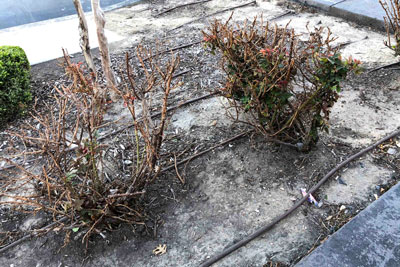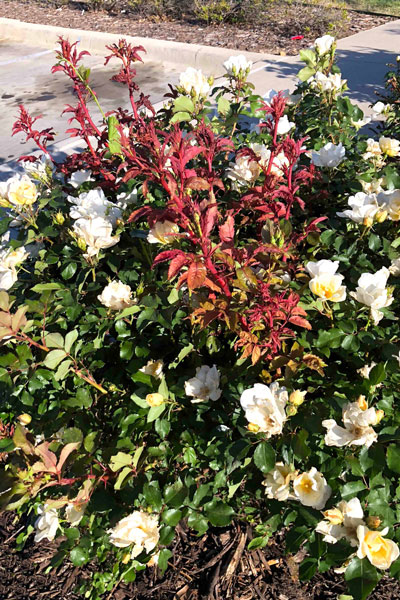Rose Rosette Continues to Spread
This fatal disease has devastated roses in the DFW Metroplex for the past 6-7 years, but it’s much more widespread than that. All it takes is a quick search of the Internet for maps of its reported locations, and you’ll see that they’re pretty much all over America.
Here in Texas the worst outbreak has been in DFW where hardly any healthy roses can be found. However, RRV has been identified in locations across South and Central Texas as well.
I have a lengthy piece that I wrote three years ago archived on my website. Click here to see it. I’ve just left it there for all who need to know, updating it as new information becomes available. I encourage you to read it and look at the photos of infected roses so you’ll know what to watch for. Symptoms are highly visible at this time of the year.

Red Knock Out roses show strong bull canes and clubby, “witches’ brooms” growth habit of flower stalks.

Bed adjacent to Red Knock Outs in photo above, but infected two years earlier. This shows the impact of RRV in just three years.
Quick facts…
• RRV is fatal to roses. It kills plants in 1-3 years.
• Some species and varieties may be resistant, but most are not. No one knows for sure which are and which aren’t at this point. Research is well underway.
• Knock Out roses have been most commonly affected. It’s not necessarily because they are more susceptible. It’s just that they have been planted in massed commercial landscapes where transmission is quick and efficient. Commercial maintenance workers are often untrained to recognize RRV and merely prune out the affected branches.
• RRV is spread by a wind-borne microscropic mite.
• We have no preventive for RRV, nor is there a cure.
• We have no means of preventing or killing the mites.
• Strong “bull canes” are one of the most visible symptoms. Their stems may be three or four times the normal diameter.

Presence of red canes in a white-flowering rose is proof of RRV infection.
• Those bull canes are typically red, even on white- and yellow-flowering plants. The red coloration remains. Note that healthy white- and yellow-flowering rose plants have only green stems and leaves with no red pigmentation at all.

RRV-infected cane shows dramatically more thorns and intense red coloration than normal. (Photo courtesy Rick Williams)
• Infected canes often have several times as many thorns as normal.
• When a plant is infected, all of the plant is infected, even if only a portion of the plant shows signs of the disease.
• Pruning out the visibly infected part does absolutely no good if you leave the rest of the plant. You must remove the entire plant, roots and all.
• Quack remedies using assorted household products accomplish absolutely nothing. If these offered any measure of help, scientists and rosarians would be roundly endorsing them. People who attempt these and leave their plants in place in the meantime are serving only to spread the disease to others’ gardens nearby.
• There is open discussion as to how long ground should be left free of roses before you replant. Most seem to feel at least one year, but there are many of us who are uncomfortable recommending roses for areas where RRV is epidemic until a work-around has been developed. If you read what I have on my website, I’ve listed several alternatives you might consider in the meantime.
